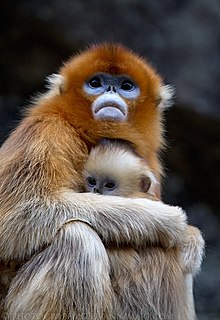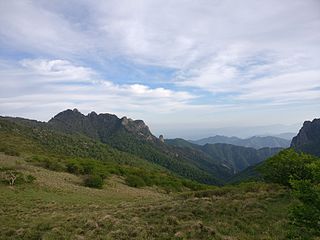
The Qinling or Qin Mountains, formerly known as the Nanshan, are a major east–west mountain range in southern Shaanxi Province, China. The mountains mark the divide between the drainage basins of the Yangtze and Yellow River systems, providing a natural boundary between North and South China and support a huge variety of plant and wildlife, some of which is found nowhere else on earth.
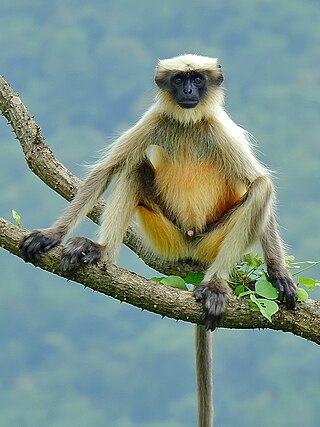
The Colobinae or leaf-eating monkeys are a subfamily of the Old World monkey family that includes 61 species in 11 genera, including the black-and-white colobus, the large-nosed proboscis monkey, and the gray langurs. Some classifications split the colobine monkeys into two tribes, while others split them into three groups. Both classifications put the three African genera Colobus, Piliocolobus, and Procolobus in one group; these genera are distinct in that they have stub thumbs. The various Asian genera are placed into another one or two groups. Analysis of mtDNA confirms the Asian species form two distinct groups, one of langurs and the other of the "odd-nosed" species, but are inconsistent as to the relationships of the gray langurs; some studies suggest that the gray langurs are not closely related to either of these groups, while others place them firmly within the langur group.

Snub-nosed monkeys are a group of Old World monkeys and make up the entirety of the genus Rhinopithecus. The genus is rare and not fully researched. Some taxonomists group snub-nosed monkeys together with the genus Pygathrix.

The black howler or black-and-gold howler, is among the largest New World monkeys and a member of the Alouatta genus. The black howler is distributed in areas of South America such as Paraguay, southern Brazil, eastern Bolivia, northern Argentina, and Uruguay. This species is sexually dimorphic, with adult males having entirely black fur and adult females and babies of both sexes having an overall golden colouring; which emphasizes black-and-gold in the name. The IUCN Red List has classed the black howler as Near Threatened as a result of a recent population reduction due to a variety of human-caused factors.

François' langur, also known as Francois' leaf monkey, the Tonkin leaf monkey, or the white side-burned black langur is a species of Old World monkey and the type species of its species group. It is one of the least studied of the species belonging to the Colobinae subfamily.

The black-and-white snub-nosed monkey, also known as the Yunnan snub-nosed monkey, is a large black and white primate that lives only in the southern Chinese province of Yunnan, where it is known to the locals as the Yunnan golden hair monkey and the black-and-white snub-nosed monkey (黑白仰鼻猴). The common name, black snub-nosed monkey, is issued to Rhinopithecus strykeri, inhabiting the Northern Sino-Myanmar border. Coniferous and deciduous forests in the mountainous regions of Yunnan are the ideal terrain for these primates. It is threatened by habitat loss, and is considered an endangered species. With their unique adaptations to their environment, these monkeys thrive at extreme altitudes despite the below freezing temperatures and thin air. This primate's diet is mainly made up of the large amounts of lichens available in their region.

The gray snub-nosed monkey, also known as Brelich's snub-nosed monkey, Guizhou snub-nosed monkey, and Guizhou golden monkey, is a species of primate in the family Cercopithecidae. It is endemic to China, where it is known as the Guizhou golden hair monkey (黔金丝猴) or gray golden hair monkey (灰金丝猴). It is threatened by habitat loss. Of the three species of snub-nosed monkeys in China, the gray snub-nosed monkey is the most threatened, with a total population thought to number fewer than 400 individuals.

The Tonkin snub-nosed monkey or Dollman's snub-nosed monkey is a slender-bodied arboreal Old World monkey, endemic to northern Vietnam. It has black and white fur, a pink nose and lips, and blue patches around the eyes. It is found at elevations from 200 to 1,200 m on fragmentary patches of forest on craggy limestone areas. First described in 1912, the monkey was rediscovered in 1989 but is exceedingly rare. Out of the five snub-nosed monkey species in the world, the Tonkin snub-nosed monkey is the rarest. In 2008, fewer than 250 individuals were thought to exist, and the species was the subject of intense conservation effort. The main threats faced by these monkeys are habitat loss and hunting, and the International Union for Conservation of Nature has rated the species as "critically endangered".
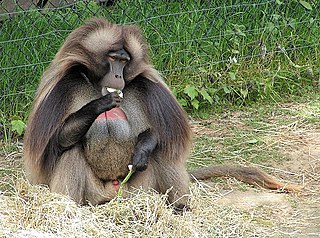
One-male groups are a type of social organization where one male interacts with a group of females and their immature offspring. Offspring of both sexes are evicted from the group upon reaching puberty. It can be seen in many species of primates, including the gelada baboon, the patas monkey, savanna baboon, sun-tailed monkey, golden snub-nosed monkey, and the hamadryas baboon. There are costs and benefits for individuals living in one-male groups. As well, individuals within one-male groups can interact with each other just like individuals can interact with those from different one-male groups.
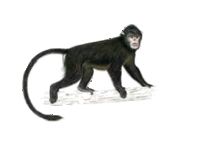
The Myanmar snub-nosed monkey or Burmese snub-nosed monkey or black snub-nosed monkey is a critically endangered species of colobine monkey discovered in 2010 in northern Burma (Myanmar). It was formally described as a novel species of primate in 2011 based on its fur, beard and tail. Two groups of the species were discovered in China in 2011 and 2015, respectively.
Laojun Mountain is a mountain in the northwest part of Yunnan Province, China. It is part of the Laojun Mountain region, which includes an area of 1,085 square kilometres (419 sq mi) with elevations ranging from 2,100 to 4,513 metres. The region includes four counties: Yulong, Jianchuan, Lanping, and Weixi. The western part of the region adjoins the Lancang River, while the eastern part is contiguous with the Jinsha River. The region was included in the Three Parallel Rivers UNESCO World Heritage Site in 2003, and the Laojun Mountain National Park was announced in January 2009.
Baihe Nature Reserve is located in northern Sichuan province in central China. It is a home of the endangered Golden snub-nosed monkey and the Giant panda. The reserve, founded in 1963, covers an area of 163 sq. kilometers. It is near the Jiuzhaigou Valley and the scenic Huanglong Scenic and Historic Interest Area.
The Gaoligongshan National Nature Reserve (GNNR) is a protected area comprising the Gaoligong Mountains and the nearby Nu Jiang Reserve in the western Yunnan Province of China, near the international border with Burma. It covers a vast stretch of the junction of Baoshan City, Tengchong, and Lushui County, towards the west side of Nu (Salween) River.
Prunus polytricha is a species of cherry native to Gansu, Guizhou, Henan, Hubei, Shaanxi and Sichuan provinces of China, typically found at 1100–3300 m above sea level. It is a shrub or low tree typically 2–12 m tall and prefers mesic hills and forest edges. It is found in old growth oak forests and in semi-cultivation in windbreaks. Its buds, leaves and seeds are consumed by the golden snub-nosed monkey.

Primate sociality is an area of primatology that aims to study the interactions between three main elements of a primate social network: the social organisation, the social structure and the mating system. The intersection of these three structures describe the socially complex behaviours and relationships occurring among adult males and females of a particular species. Cohesion and stability of groups are maintained through a confluence of factors, including: kinship, willingness to cooperate, frequency of agonistic behaviour, or varying intensities of dominance structures.

Prunus kansuensis, sometimes called the Chinese bush peach, is a putative species of peach native to China. It is found in Gansu, Guizhou, Hubei, Qinghai, Shaanxi and Sichuan provinces. It is a shrub or tree 3 to 7 m tall, preferring to grow at 1,000 to 2,300 m above sea level. A genetic and morphological study has shown that it is conspecific with Prunus persica, the cultivated peach. P. kansuensis is being investigated as a source for rootstocks and for crop improvement due to its resistance to multiple diseases, to drought, and to frost. It is unaffected by peach mosaic virus, resistant to the root-knot nematode Meloidogyne incognita, and tolerates winter temperatures down to −35 °C (−31 °F).
Prunus setulosa is a species of cherry found in Gansu, Guizhou, Hubei, Ningxia, Qinghai, Shaanxi and Sichuan provinces of China. A shrub or small tree 1.5 to 5 m tall, it prefers to grow in forests or thickets in mountain ravines between 1300 and 2,600 m above sea level. Its leaves are eaten by the gray snub-nosed monkey Rhinopithecus brelichi. Its inflorescences are umbels with two or three flowers. The sepals are leaf-like, and the petals are pink. There are 30 to 40 stamens. It blooms April through June and bears red fruits June through August.
Prunus rufoides, called Diel's cherry, the tawny bark cherry, and in Chinese: 尾叶樱桃, the tailed-leaf cherry, is a species of cherry native to China, preferring to grow at 500–1400 m above sea level, but reaching 1800 m. The fruits are eaten by masked palm civets and the fruits, leaves and buds are eaten by gray snub-nosed monkeys.

The Qin Ling Mountains deciduous forests ecoregion covers the Qin Mountains, which run west-to-east across central China. The mountains effectively divide the biological regions of China into north and south. To the north is the Yellow River basin, a loess-soil region of temperate deciduous forests. To the south is the Yangtze River basic, a subtropical forest region. In between, the Qin Mountains support many rare and endemic species, including the Giant panda and the Sichuan snub-nosed monkey.

Castanea seguinii, called Seguin chestnut, Seguin's chestnut, or Chinese chinquapin, and in Chinese: 茅栗, mao li, is a species of chestnut native to south‑central and southeast China.
